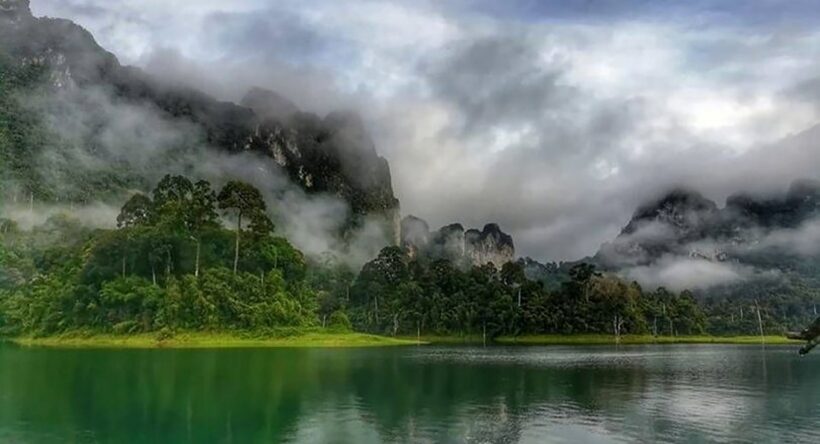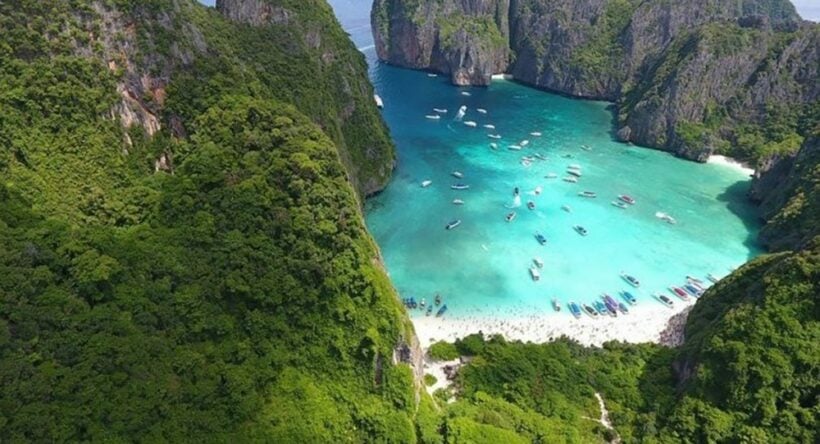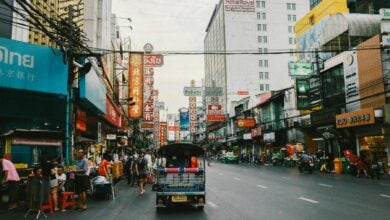SPECIAL REPORT: Saving paradise by setting limits

By Piyaporn Wongruang
Maya Bay has finally been closed down. On Thursday, park rangers at Had Nopparat Tara-Mu Ko Phi Phi marine national park placed buoys demarcating a no-access zone to prevent tourist boats getting in, as a part of a long-term rehabilitation process for the park’s world-renowned Maya Bay.
The bay was made famous by the 2000 Hollywood film “The Beach” starring Leonardo DiCaprio, but has subsequently been ecologically degraded by the excessive number of tourists – a daily average of about 4,000 people and 200 boats.
Following a recommendation by marine experts, the National Parks Department decided to put the bay off-limits from yesterday until September 30.
The closure is seen as an entry point for a new approach to tourism management at the park, and would also set a new standard for another 26 Thai marine parks that also bear a similar burden, according to the department.
Maya Bay is just another story of a timely rescue of the country’s natural attractions before it is too late.

For years, national parks around the country have seen an influx of visitors who wish to enjoy nature, with resulting tourism-based pressures degrading their often sensitive ecosystems.
In a bid to cope with such the building threat posed by these pressures, the department has come up with measures to ensure that national parks nationwide, 131 in total, can respond effectively to tourism impacts.
The concept of “Green National Parks” has been introduced to guide tourism management in the parks, with trophies set to reward good practitioners, and at the same time hopefully to lead ultimately to sustainable tourism that is kept within the ecological carrying capacity of these precious idylls.
“If a number of tourists visit our places, but they are later damaged, we should consider that a failure of our national park mission. We would be successful only when our places are still in a good condition despite their intensive visits. It really much depends on management,” said Songtham Suksawang, a director of the department’s National Parks Office.
 Khao Sok National Park won an award last year along with other 14 parks for being “green national parks”
Khao Sok National Park won an award last year along with other 14 parks for being “green national parks”
More park function
Since the first national park, Khao Yai, was declared nearly 60 years ago, national parks have always aimed to help preserve the natural values of the ecosystems of the country’s forests.
As explained by the department’s deputy chief, Jongklai Worapongsathorn, the department’s prime mission when it was first separated from the Royal Forestry Department as an independent department in 2002 was to take care of national parks, seen as the core areas of the country’s ecosystems.
Since then, tourism in national parks has been left largely unattended, with management following the park chief’s capacities and directives. Areas were zoned to aid in better management and boundaries of the heavily used recreational areas determined using better criteria.
The number of tourists visiting the parks were already a concern and some pilot projects to limit tourist access were introduced, along with measures to keep the parks clean and more environmental friendly such as a ban on foam-based food packages and actions to reduce energy use among others.
The department studied the carrying capacity of the parks, and the issue took on more importance over the years, though limits were not initially imposed. Over the past decade, those limits have been phased in for some popular national parks, including Khao Yai.
“I, myself, also did not think that one day we would get serious about this,” said Jongklai to national park chiefs attending a recent workshop to guide green national park practices for 2018. “We have seen more and more of an influx of tourists during a particular period, such as the New Year, but I think in the near future we will have to enforce limits on access to national parks regularly and popularly, as we have seen happen at some popular parks, be they Phi Phi, Similan and others.
“If we don’t adjust ourselves now (to handle tourists), we will never be able to catch up on the trend,” said Jongklai.
Influx of tourists
As recorded by the Tourism Department, tourist visits to national parks have increased over the past five years from around 11 million to 18 million last year – over half of them foreigners.
Tourism is a key driver of the country’s economy, with the income contributing nearly Bt2.9 trillion last year, according to the department.This year, it is expected that around Bt3.3 trillion will be contributed by tourism.
Tourism has also driven the country’s competitiveness to the rank of 34 out of 136 countries, the department has noted. But when environmental aspects are factored in, that ranking falls to 122, with micro dust, intensive environmental damage and threats to plant and wildlife species being the prime problems pulling the country down in rank.
Concerned parties all agree that national parks play a vital role in drawing tourists, and that role has been increasing over the years. The question is how to make it sustainable.
“The role of our national parks in tourism will never decrease, but will instead increase as more and more foreign tourists increasingly appreciate our nature and visit parks to experience it,” said Prommeth Nathomthong, a deputy director of the Tourism Authority of Thailand.
“From a tourism aspect, [the national parks] are vital tools to help drive our economy. … The question is how to make them sustainable, keep them in the good condition they are supposed to be in,” said Prommeth. He suggests that the concept of sustainable tourism should guide the tourism management of the parks.

Green National Parks
Sustainable tourism is clearly addressed in the 20-year national strategy, with carrying capacity being part of the strategy to help drive the country’s competitiveness and sustainable growth.
The National Parks department has adopted the concept and improved the guidelines to be followed by national parks in an effort to empower them to respond to tourism pressures.
Six areas of environmental management, and 17 related measures, have been introduced to national parks nationwide as a guideline for managing tourism and its impacts within their boundaries. The six areas are: environmental management of park offices, environmental and landscape management of the parks, saving energy, waste disposal, tourist facilities and safety.
In 2016 the department began giving out a yearly award to those completing the guidelines to it was the first year that the department gave an award to those completing the guideline. Eight national parks won the award first year, with 14 more earning it in 2017.
The department expects that in the next eight years, all the national parks will complete the guidelines and thus adhere to an international standard of practice.
“Our national parks are green by nature, but they will be not if disturbed – and now they are disturbed by tourism activities. That’s the reason why we have to have the green concept to help guide us to sustainable practices. Or our resources, coral reefs for instance, will be irreparably damaged,” said Songtham.
And addressing the problems head-on this way will not add yet another burden to the parks, he concluded.
Original report HERE.
Join the conversation and have your say on Thailand news published on The Thaiger.
Thaiger Talk is our new Thaiger Community where you can join the discussion on everything happening in Thailand right now.
Please note that articles are not posted to the forum instantly and can take up to 20 min before being visible. Click for more information and the Thaiger Talk Guidelines.
Leave a Reply
You must be logged in to post a comment.









